Daniel Sherrier's Blog, page 34
August 11, 2016
Today’s Super Comic — The Tick #6 (1989)
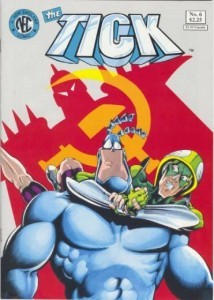 While I’m in a silly mood, let’s dig up an old issue of The Tick.
While I’m in a silly mood, let’s dig up an old issue of The Tick.
Writer/Artist Ben Edlund created a highly entertaining superhero parody that has fun with the genre without ever bashing it. And this genre absolutely has numerous absurd tropes that basically demand to be mocked (from a place of love, of course).
In The Tick #6, we meet wannabe superhero the Running Guy (he runs faster than ten fast men!), who spends a pretty penny renting a fake super-villain to fight so he can start building a rep. It’s that or go back to his bank job. Alas for the Running Guy, the Tick finds the fake super-villain first and is overjoyed at the prospect of having a real bad guy to thwart.
But before that, the Tick gets his first look at his new chum Arthur’s apartment, which has a disappointing lack of crime-busting equipment.
The Tick is like the Leslie Nielsen of superheroes. He takes his work seriously while remaining totally unaware of how ridiculous everything around him is…or how ridiculous he’s being.
Silliness abounds, and it’s a delight.
Writer/Penciler: Ben Edlund
Inker: Dave Garcia
Publisher: New England Comics Press
How to Read It: back issues; included in The Tick Omnibus: Sunday through Wednesday (TPB)
Appropriate For: ages 9 and up
August 10, 2016
Today’s Super Comic — Captain America: Sentinel of Liberty #11 (1999)
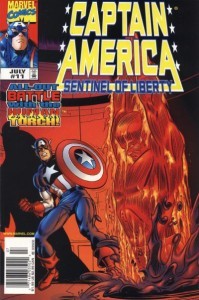 Sometimes a completely goofy book hits the spot.
Sometimes a completely goofy book hits the spot.
Sentinel of Liberty was Captain America’s answer to Batman’s Legends of the Dark Knight, an opportunity to tell out-of-order tales from various points throughout Cap’s long career. Unlike Batman’s book, Cap’s didn’t last long, but it featured entertaining stories by Mark Waid and various artists.
The silliest entry in the series was by far #11, which takes us back to an equally silly (if less intentionally so) Silver Age story. Back in 1963, before Cap was revived in the then-modern era, Marvel tested him out by having a Captain America imposter face off against the Human Torch in Strange Tales #114. And let’s just say, that’s not a comic that will appear in this series of positive reviews.
Sentinel of Liberty #11 has fun with the Silver Age story. Lots of fun. The issue is framed around the present-day Human Torch recounting the “classic” adventure to a disbelieving Cap (who of course was still on ice as it was all going down…there’s a visual representation in case you had forgotten). The Torch is treated as an unreliable narrator, though he’s amusingly accurate in his recollections, right down to his girlfriend calling for someone to “send some new linoleum over right away,” the Torch getting trapped in an asbestos-lined van, and the expensive lengths to which the Cap imposter goes to rob banks.
Not every comic needs to strive to be The Best Ever. It’s perfectly okay to merely deliver unpretentious, good-natured fun. And this one does so with excellent cheer.
Writer: Mark Waid
Pencilers: Walter McDaniel and Anthony Williams
Inkers: Whitney McFarland and Andy Lanning
Publisher: Marvel Comics
How to Read It: back issues
Appropriate For: ages 9 and up
August 9, 2016
Today’s Super Comic — X-Factor #14 (2007)
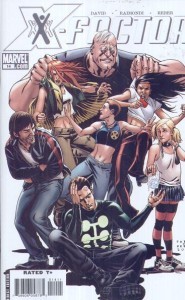 The X-Men titles weren’t in their strongest state a decade ago, but hands-down the shining light of the bunch was Peter David’s superb X-Factor. And the book continues to hold up as one of the best X-series since the late ‘70s/early ‘80s glory days, largely due to David’s masterful scripting.
The X-Men titles weren’t in their strongest state a decade ago, but hands-down the shining light of the bunch was Peter David’s superb X-Factor. And the book continues to hold up as one of the best X-series since the late ‘70s/early ‘80s glory days, largely due to David’s masterful scripting.
X-titles excel when they focus on a core cast, rather than an ever-sprawling society of mutants, and X-Factor showcases a specific grouping of underutilized second-stringers. David finds the untapped potential in each one, especially the ostensible lead, Jaime Madrox, the Multiple Man. The result is a fantastic ensemble that drives multiple ongoing storylines.
Issue #14 exemplifies the book’s strengths. It kicks off a new storyline in which Madrox resolves to track down his various duplicates who have gone astray during his quest to accumulate diverse knowledge and life experiences. But as it sets up that storyline, it checks in on the various subplots, mining ample humor from a soap opera situation involving Madrox, Siryn, and Monet and resolving a Guido subplot in an unexpectedly touching way.
It’s a book with tremendous tonal agility. Artist Pablo Raimondi paces the “talking heads” scenes perfectly, as he skillfully uses silent panels to allow the comedic beats to land.
While #14 is a great example, you should really start with the Madrox limited series that piloted the book, proceed to #1, and read through the end. It loses a little bit of steam in later storylines, but David’s entire run, regardless of artist, includes not one bad issue. Truly one of my favorite X-books of all time.
Writer: Peter David
Artist: Pablo Raimondi
Publisher: Marvel Comics
How to Read It: back issues; Marvel Unlimited; Comixology; included in X-Factor vol. 3: Many Lives of Madrox (TPB)
Appropriate For: ages 13 and up
August 8, 2016
Today’s Super Comic — Spider-Man #1 (2016)
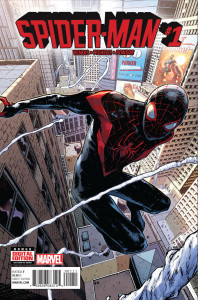 Not every Spider-Man stars Peter Parker these days, and this has been the case for the past several years. Marvel’s alternate-universe Ultimate line replaced its teenaged Peter Parker with an entirely new teenaged character, Miles Morales, who was met with acclaim by readers and critics alike.
Not every Spider-Man stars Peter Parker these days, and this has been the case for the past several years. Marvel’s alternate-universe Ultimate line replaced its teenaged Peter Parker with an entirely new teenaged character, Miles Morales, who was met with acclaim by readers and critics alike.
I never got around to reading Miles’s series, primarily because I can’t read everything and Spider-Man is Peter Parker. (I didn’t read the stretch of issues where Doctor Octopus was pretending to be Spider-Man either.) I was glad to see people getting excited about a new Spider-Man, but it wasn’t my Spider-Man. I was around in the days when Superman got replaced by four imposters, Batman got replaced by a psycho, and Green Lantern went crazy and got replaced by an inexperienced younger guy. So I’m a bit biased against replacements who weren’t well-established proteges (like Wally West, Dick Grayson, or Sam Wilson becoming Flash, Batman, or Captain America). This may have been my mistake.
Due to events I’m unfamiliar with, Miles has somehow found his way to the Marvel Universe proper and coexists with the original Spidey. But I wasn’t the least bit lost when I decided to check in on the new Spider-Man #1 when it hit Marvel Unlimited.
The comic effectively introduces him to new readers and introduces his Marvel Universe status quo to preexisting fans, and it does so without any deluge of exposition. We see Miles in both his school and his superhero lives, and we meet his parents and best friend, getting a sufficient sense of who everyone is and what the dynamics between them are. Writer Brian Michael Bendis captures the spirit of Spider-Man in this (relatively) new character—Miles is a good kid who tries to do the right thing, even though doing the right thing often causes personal problems for him, whether it’s losing a date or letting his report card take a hit.
He may not be the Spider-Man of my youth, but so far Miles Morales looks like a worthy Spider-Man to me.
And the cliffhanger guarantees I’ll check out the second issue.
Writer: Brian Michael Bendis
Artist: Sara Pichelli
Publisher: Marvel Comics
How to Read It: recent back issues; Marvel Unlimited; Comixology
Appropriate For: ages 10 and up
August 7, 2016
Today’s Super Comic — The Invincible Iron Man #150 (1981)
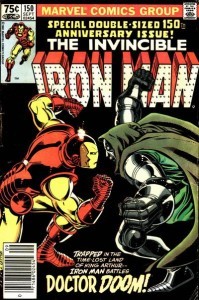 Iron Man vs. Doctor Doom…in Camelot.
Iron Man vs. Doctor Doom…in Camelot.
Yep, it’s classic comic book action that places its protagonist out of his element, doubly so. Not only is the electronically powered superhero stranded in a pre-electronics era, with no way to recharge his armor, but he also has to battle magical forces, which are basically the opposite of his comfort zone.
And Doctor Doom fits very well as an Iron Man foe, representing the dark side of technology. And yet he’s also perfectly comfortable with mysticism in a way Iron Man will never be, giving the bad guy a distinct advantage. (All of which is why Doctor Doom has been a welcome addition to recent Iron Man issues.)
The Invincible Iron Man #150 holds up as lots of fun, though it’s easy to picture how differently it would be written today. Tony Stark of the 1980s was much more Tom Selleck than Robert Downey Jr., and an adventure of this scale could easily fill six issues or more, rather than being set up in #149 and playing out in the double-sized #150.
As it stands, however, it’s a memorable time-travel story with a ridiculously fantastic premise and enjoyable execution. It’s not literature, but it sure is a wild ride.
Writer: David Michelinie
Penciler: John Romita, Jr.
Inker/Co-Plotter: Bob Layton
Publisher: Marvel Comics
How to Read It: back issues; Marvel Unlimited; Comixology; Iron Man vs. Doctor Doom: Doomquest (HC)
Appropriate For: ages 9 and up
August 6, 2016
Today’s Super Comic — Detective Comics #646 (1992)
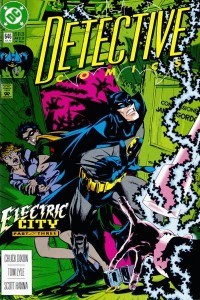 This review series is basically an extended “thank you” to the industry that has provided me with ample enjoyment over the course of many years, particularly in my youth, so I have to acknowledge the first mainstream superhero comic I ever read.
This review series is basically an extended “thank you” to the industry that has provided me with ample enjoyment over the course of many years, particularly in my youth, so I have to acknowledge the first mainstream superhero comic I ever read.
Detective Comics #646. Part three of a three-part storyline. Also the conclusion of writer Chuck Dixon’s first story arc on the title. Starring Batman and Robin as they try to save Commissioner Gordon and his girlfriend Detective Sarah Essen from an electrically powered lunatic hell-bent on revenge.
Previously, my main exposure to Batman was reruns of the Adam West show, which of course I loved. It was so much fun, and innocent fun at that, with all the bright colors and POW! BOP! ZAP!
Then I open this comic, and the villain actually zaps a man—and kills him—right on the second page. It’s nothing gory, and it’s not gratuitous. Rather, it serves the (at the time) new Robin’s ongoing development, as young Tim Drake continues to learn just how dangerous his new life is. A tense confrontation with the villain later in the issue hammers the lesson in a bit further.
At the time, of course, I didn’t realize this Robin was new and wasn’t Dick Grayson, and I doubt I could have articulated how the stakes appeared much higher and more genuine than in the old TV show. Nor did I notice that Robin grew up a little more somewhere between page 1 and page 22 (that certainly didn’t happen on television).
But I did understand that this comic was far better than POW! BOP! ZAP! and I would be coming back for more. Lots more.
Writer: Chuck Dixon
Penciler: Tom Lyle
Inker: Scott Hanna
Publisher: DC Comics
How to Read It: back issues; Comixology;
Appropriate For: ages 9 and up
August 5, 2016
Today’s Super Comic — The Vision #4 (2016)
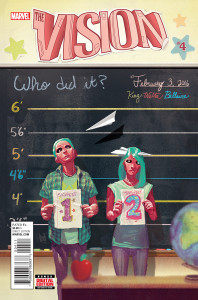 Many Avengers are capable of carrying their own series, but Vision never struck me as a strong candidate for a solo outing. A cold, emotionally detached android works much better in supporting roles.
Many Avengers are capable of carrying their own series, but Vision never struck me as a strong candidate for a solo outing. A cold, emotionally detached android works much better in supporting roles.
An entire family of androids, however…
It feels obvious once you see it, but the Vision has always been a family man. Naturally, a Vision comic should focus on family…and a highly unsettling family at that.
Vision is just trying to live a normal life in an Arlington suburb, with his wife Virginia and teenage kids Vin and Viv. He created all three himself, of course, which is already far from normal. An old enemy’s visit in #1 causes Virginia to go all Walter White, and the consequences continue to compound in #4. (I’m half-expecting her to proclaim, “Everything I did, I did for this family!”)
Writer Tom King has achieved an impressive feat with this series so far (based on what’s available on Marvel Unlimited). This is hardly even a superhero book. It’s almost a horror book with androids, but it also features heart and humor. The kids perform a fun twist on Charlie Brown’s football woes at the beginning of The Vision #4, and Viv’s interaction with a classmate shows the humanity beneath the artificial exterior. But then that ending…will not be spoiled here.
Okay, I’m sold on a Vision series. Not a solo superhero book, but Vision as the head of an unusual household? Yes, that apparently works.
Writer: Tom King
Artist: Gabriel Hernandez Walta
Publisher: Marvel Comics
How to Read It: recent back issues; Marvel Unlimited; Comixology; included in Vision vol. 1: Little Worse Than a Man (TPB)
Appropriate For: ages 14 and up
August 4, 2016
Today’s Super Comic — Invincible Iron Man #6 (2016)
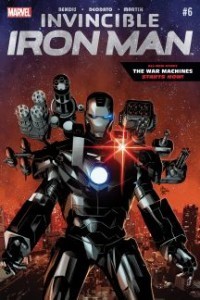 Iron Man and Doctor Doom have breakfast together. How’s that for a compelling hook?
Iron Man and Doctor Doom have breakfast together. How’s that for a compelling hook?
Just an ultra-quickie review this time, as The Invincible Iron Man’s stellar quality continues in the latest issue added to Marvel Unlimited. Not the latest-latest issue…I have this unfortunate allergy to paying $3.99 per issue. I remember the days of paying a buck and a quarter, gosh darn it!
James “War Machine” Rhodes joins the action this issue, and so does artist Mike Deodato, who can always be counted on to deliver aesthetically pleasing pages. The breakfast with Doom showcases writer Brian Michael Bendis’s flair for snappy dialogue, especially with Tony’s new romantic interest, Amara, thrown into the mix.
It’s a fun time all around, almost enough to help me overcome my $3.99 allergy. (Well, no, but maybe subscriptions are a better deal…?)
Writer: Brian Michael Bendis
Artist: Mike Deodato
Publisher: Marvel Comics
How to Read It: recent back issues; Marvel Unlimited; Comixology
Appropriate For: ages 13 and up
August 3, 2016
Today’s Super Comics — Fantastic Four: Unstable Molecules #1-4 (2003)
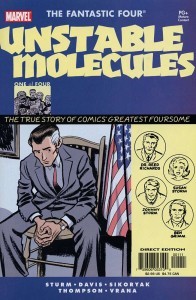 Fantastic Four: Unstable Molecules is not a typical Marvel comic, nor is it even a superhero story.
Fantastic Four: Unstable Molecules is not a typical Marvel comic, nor is it even a superhero story.
The covers bill it as “The True Story of Comics’ Greatest Foursome,” but it’s based on a true story in the same way the movie Fargo is based on a true story—not actually, but it commits to pretending it is.
So this miniseries pretends that the members of the Fantastic Four are based on real people from 1950s America, and it presents them in all their dysfunctional glory. We meet a Reed who’s trying to stretch his mind to achieve a scientific breakthrough, a Sue who feels invisible, a Johnny who’s a hotheaded angry kid, and a Ben who can be a bit of a jerk. Each one corresponds to their FF counterpart, but none are heroes. They’re just deeply flawed people going about their lives and getting caught up with the Cold War, societal expectations, Beatniks, or their own worst impulses.
And it’s all fascinating, particularly the second part, which focuses primarily on Sue. She’s 26, orphaned, struggling to raise her teenage brother, dating a much older scientist who’s too wrapped up in his work to notice her, and subjected to the judgment of the older women in her neighborhood. A comic within the comic that Johnny reads depicts a ‘50s-style super-heroine, and its panels convey Sue’s state of mind as she endures a rough day in a generally unhappy life.
James Sturm, the founder of the Center for Cartoon Studies, has written a truly unique Fantastic Four book, one that feels much more indie than Marvel. And it’s a nice change of pace indeed.
This is a comic that has things to say, and it’s worth a look even if you couldn’t care less about the Fantastic Four.
Writer/Layouts: James Sturm
Artist: Guy Davis
Publisher: Marvel Comics
How to Read It: back issues; Marvel Unlimited; Fantastic Four: Unstable Molecules (TPB)
Appropriate For: ages 17 and up
August 2, 2016
Today’s Super Comic — Wonder Woman #184 (2002)
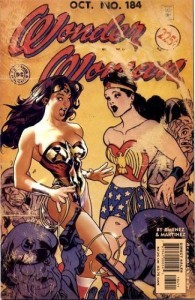 Writer/Artist Phil Jimenez had a terrific run on Wonder Woman that shows how to do a good, solid superhero book that’s fun for kids and adults alike.
Writer/Artist Phil Jimenez had a terrific run on Wonder Woman that shows how to do a good, solid superhero book that’s fun for kids and adults alike.
It’s been a while since I’ve read any of the Jimenez issues, and I’m regrettably missing a good chunk of them. But every issue I do have is a winner. I grabbed one at random, issue #184, and was treated to time-travel, dinosaurs, evil Nazis, shrunken super-villains, two Wonder Women, a tribute of sorts to an old World War II super-heroine, a respectable new romantic interest who got dragged along for the ride, and stellar artwork throughout. All in 22 pages!
This is a comic book that’s so delightfully unembarrassed to be a comic book. It embraces the superhero genre’s absurdity and reminds you why you love it. Plus, the book portrays a likeable, kind, heroic Wonder Woman who makes a great role model for younger readers. (More recent Wonder Woman comics I’ve read haven’t been so kid-friendly, which is a loss for kids.)
Now I want to track down those missing issues.
Writer/Penciler: Phil Jimenez
Inker: Andy Lanning
Publisher: DC Comics
How to Read It: back issues; Comixology
Appropriate For: ages 9 and up



